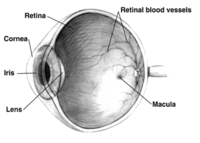
Photo from wikipedia
Abstract Sensory drive, the concept that sensory systems primarily evolve under the influence of environmental features and that animal signals are evolutionarily shaped and tuned by these previously existing sensory… Click to show full abstract
Abstract Sensory drive, the concept that sensory systems primarily evolve under the influence of environmental features and that animal signals are evolutionarily shaped and tuned by these previously existing sensory systems, has been thoroughly studied regarding visual signals across many animals. Much of this work has focused on spectral aspects of vision and signals. Here, I review work on polarized-light signals of animals and relate these to what is known of polarization visual systems, polarized-light aspects of visual scenes, and polarization-related behavior (e.g., orientation, habitat-finding, contrast enhancement). Other than the broad patterns of scattered polarized light in the sky, most polarization in both terrestrial and aquatic environments results from either reflection or scattering in the horizontal plane. With overhead illumination, horizontal features such as the surfaces of many leaves or of air: water interfaces reflect horizontal polarization, and water scatters horizontally polarized light under most conditions. Several animal species have been demonstrated to use horizontally polarized light fields or features in critical aspects of their biology. Significantly, most biological signals are also horizontally polarized. Here, I present relevant polarization-related behavior and discuss the hypothesis that sensory drive has evolutionarily influenced the structure of polarization signals. The paper also considers the evolutionary origin of circular polarization vision and circularly polarized signals. It appears that this class of signals did not evolve under the influence of sensory drive. The study of signals based on polarized light is becoming a mature field of research.
Journal Title: Current Zoology
Year Published: 2018
Link to full text (if available)
Share on Social Media: Sign Up to like & get
recommendations!